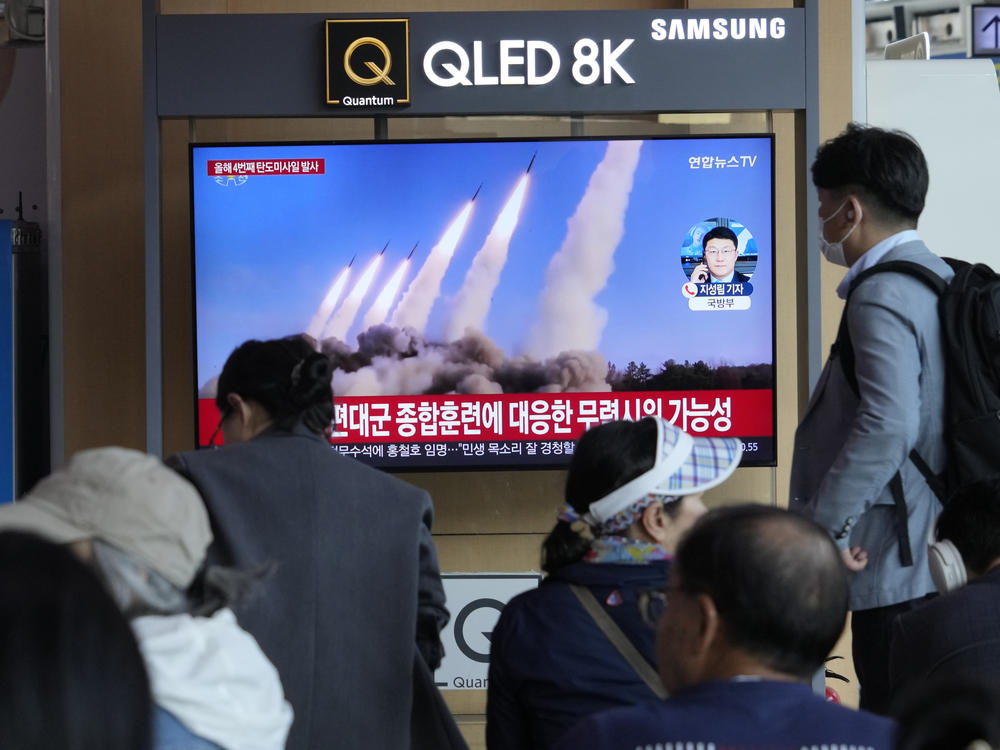Section Branding
Header Content
North Korean leader Kim led rocket drills that simulated a nuclear counterattack
Primary Content
SEOUL, South Korea — North Korean leader Kim Jong Un supervised salvo launches of the country's "super-large" multiple rocket launchers that simulated a nuclear counterattack against enemy targets, state media said Tuesday, adding to tests and threats that have raised tensions in the region.
The report by North Korea's official Korean Central News Agency came a day after the South Korean and Japanese militaries detected the North firing what they suspected were multiple short-range ballistic missiles from a region near its capital, Pyongyang, toward its eastern seas.
Analysts say North Korea's large-sized artillery rockets blur the boundary between artillery systems and ballistic missiles because they can create their own thrust and are guided during delivery. The North has described some of these systems, including the 600mm multiple rocket launchers that were tested Monday, as capable of delivering tactical nuclear warheads.
KCNA said Monday's launches represented the first demonstration of the country's nuclear-weapons management and control system called "Haekbangashoe," or "nuclear trigger." The report described the drill as aimed at demonstrating the strength and diverse attack means of North Korea's nuclear forces amid deepening tensions with the United States and South Korea, which it portrayed as "warmongers" raising tensions in the region with their combined military exercises.
State media photos showed at least four rockets being fired from launch vehicles as Kim watched from an observation post. It said the rockets flew 352 kilometers (218 miles) before accurately hitting an island target and that the drill verified the reliability of the "system of command, management, control and operation of the whole nuclear force."
KCNA said Kim expressed satisfaction, saying that the multiple rocket launchers were as accurate as a "sniper's rifle."
He said the drill was crucial for "preparing our nuclear force to be able to rapidly and correctly carry out their important mission of deterring a war and taking the initiative in a war in any time and any sudden situation." The comments reflected North Korea's escalatory nuclear doctrine, which authorizes the military to launch preemptive nuclear strikes against enemies if it perceives the leadership as under threat.
South Korea's Joint Chiefs of Staff said the weapons from Monday's launches flew about 300 kilometers (185 miles) before crashing in the waters between the Korean Peninsula and Japan. The ranges suggested the weapons would likely target sites in South Korea. The latest launches came as South and the United States have been conducting a two-week combined aerial exercise that continues through Friday aimed at sharpening their response capabilities against North Korean threats.
When asked about the North Korean claims, Lee Sung Joon, spokesperson of South Korea's Joint Chiefs of Staff, said it remains unclear whether the North perfected the designs for small, battlefield nuclear weapons that could fit on its rockets. He insisted the North was likely exaggerating the accuracy of its multiple rocket launcher systems and that South Korea would be able to detect and intercept such weapons, without elaborating on specific missile defense capabilities.
Lee said it was possible that the North used the drill to test the multiple rocket launchers it potentially plans to export to Russia as the countries expand their military cooperation in the face of separate, intensifying confrontations with the United States. The U.S. and South Korea have accused North Korea of transferring artillery shells, missiles and other munitions to Russia to help extend its warfighting in Ukraine.
North Korea in recent months has maintained an accelerated pace in weapons testing as it continues to expand its military capabilities while diplomacy with the United States and South Korea remained stalled. Outside officials and analysts say Kim's goal is to eventually pressure the United States into accepting the idea of the North as a nuclear power and negotiating economic and security concessions from a position of strength.
In response to North Korea's evolving nuclear threats, the United States and South Korea have been strengthening their bilateral military drills and trilateral exercises with Japan. The countries are also sharpening their nuclear deterrence strategies built around strategic U.S. assets.
In past years, North Korea has test-fired nuclear-capable missiles designed to strike sites in South Korea, Japan and the mainland U.S. Many experts say North Korea already possesses nuclear missiles that can reach all of South Korea and Japan, but it has yet to develop functioning intercontinental ballistic missiles that can travel to the continental U.S.
The latest launches came days after North Korea announced Saturday it tested a "super-large" cruise missile warhead and a new anti-aircraft missile in a western coastal area earlier last week. In early April, North Korea also test-launched what it called a solid-fuel intermediate-range missile with hypersonic warhead capabilities, a weapon that experts say is meant to attack remote targets in the U.S. Pacific territory of Guam and beyond.

